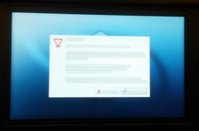I'm trying to boot SuperZaxxon from SD on my CC unit. I did the following:
Downloaded http://openpandora.org/firmware/pandora-rootfs.tar.bz2
Formatted SD card as EXT2
As root on my Fedora Desktop, extracted the files onto the card (tar -xf /path/to/pandora-rootfs.tar.bz2)
Copied the example boot.txt from http://openpandora.org/firmware/README.txt to the root of the card
Symlinked /boot/uImage to the 2.6 one
When I boot from the card it looks like this and freezes. Where is my mistake?
Downloaded http://openpandora.org/firmware/pandora-rootfs.tar.bz2
Formatted SD card as EXT2
As root on my Fedora Desktop, extracted the files onto the card (tar -xf /path/to/pandora-rootfs.tar.bz2)
Copied the example boot.txt from http://openpandora.org/firmware/README.txt to the root of the card
Symlinked /boot/uImage to the 2.6 one
When I boot from the card it looks like this and freezes. Where is my mistake?


